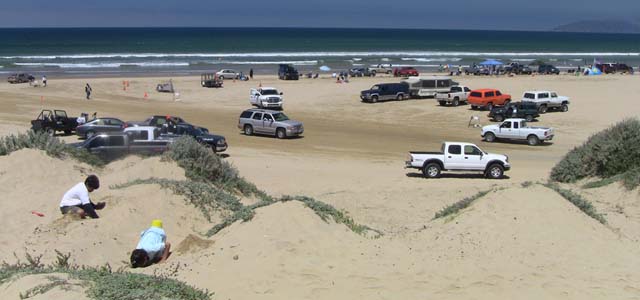Oceano Dunes closures planned despite disputed pollution reports
April 26, 2018

By JOSH FRIEDMAN
Despite mounting evidence indicating the San Luis Obispo County Air Pollution Control District (APCD) used flawed science to deem the Oceano Dunes off-road riding area a public nuisance, the APCD and California state parks have reached a new agreement to shut down portions of the park to off-road vehicles in an attempt to reduce dust flows coming from the dunes. [Cal Coast Times]
The new proposal seeks to reduce particulate matter emissions by about 50 percent, rather than 30 percent as previously proposed. The proposal requires approval from the APCD hearing board before it can be adopted, with a meeting scheduled for 9 a.m. on April 30 at the Board of Supervisor Chambers.
For years, the APCD and Nipomo Mesa residents have clashed with state parks and off-road vehicle riders over Oceano Dunes dust flows. In 2011, the air district adopted the Oceano Dunes dust rule, which requires state parks to reduce the amount of particulate matter blowing from the dunes off-roading area or face fines of $1,000 per day.
In adopting the regulation, the APCD relied on contested studies that concluded off-road vehicles on the dunes were causing pollution on the Nipomo Mesa. The APCD also claimed that crystalline silica, which commonly appears in nature as quartz, made up a significant portion of the dust blowing onto the Nipomo Mesa and that it created a cancer risk for residents.
“While not specifically measured in the study, crystalline silica can be a significant portion of wind-blown sand and soil, and is a known lung cancer hazard in occupational settings; it can also cause fibrotic lung disease,” former air district chief Larry Allen stated in a March 2010 APCD staff report.
Allen, the architect of the dust rule, was referencing a particulate matter study conducted by the air district. In the same report, Allen also stated, “Silicon was the most common element found in the coarse fraction of the particle samples analyzed.”
In early 2017, The California Coastal Commission weighed in repeating the claim that the issue with public health stemmed from the silica content.
“As described by the APCD and the Superior Court, the dust emissions are injurious to public health, offensive to the senses and interfere with the comfortable enjoyment of life within the meaning of nuisance…because the dust emissions are largely comprised of crystalline silica, which is known to be highly toxic,” according to a March 29, 2017, letter from the commission.
Later, in 2017, the APCD conducted air sampling tests for crystalline silica. Yet the agency refrained from publishing the test results.
Meanwhile, state parks conducted its own crystalline silica tests and did release the results. State parks’ tests showed crystalline silica levels were below the detection limit.
Recently, while opponents of the dust rule have criticized the air district’s claims about the presence of crystalline silica, Allen has said the issue of silica is a red herring.
In addition, a 2018 report by the Scripps Institution of Oceanography at UC San Diego found that much of the dust blowing on the mesa is biological from the ocean and not the sand dunes.
Following the adoption of the dust rule, the regulation became the subject of a multi-year court battle, during which the APCD was barred from requiring state parks to obtain a permit to operate the riding area. The air district and state parks have since engaged in multiple rounds of talks on reaching a settlement.
Last month, the APCD and state parks agreed to a pollution abatement order that would have required state parks to fence off about 100 acres of riding area in order to create islands of vegetation within the Oceano Dunes. The order would also have required the implementation of plans to achieve yearly 5 percent reductions in particulate matter emissions through 2024, or about a 30 percent reduction over a five-year period.
However, the deal between the APCD and state parks was met with opposition from both sides, with supporters of off-road activity arguing against more closures of riding area saying the agreement is based on faulty science.
Nipomo residents, many who are stilling repeating concerns from the controversial APCD study, voiced opposition to the earlier proposed agreement, arguing it did not do enough to reduce emissions and air pollution on the Mesa.
After hearing from the public last month, the hearing board, a five-member body that is separate from the agency’s board of directors, shot down the agreement saying it did not go far enough to cut dust emissions.
In the proposed agreement released this week, state parks agreed to a target of a 50 percent reduction of dust emissions over the next five years. The agreement also requires the fencing off of riding areas for vegetation islands.
Presently, there are already 186 acres of fenced vegetation islands on the dunes, according to a map circulated by the APCD.
The APCD and state parks’ latest agreement also outlines other conditions, including the formation of a scientific advisory group. The advisory group would meet at least once a year to discuss emission reductions efforts.
Despite agreeing to the various terms in the deal, state parks still denies that off-roading is causing the pollution on the Nipomo Mesa.






The comments below represent the opinion of the writer and do not represent the views or policies of CalCoastNews.com. Please address the Policies, events and arguments, not the person. Constructive debate is good; mockery, taunting, and name calling is not. Comment Guidelines